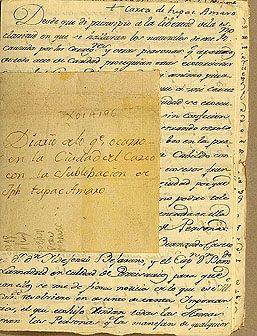"Diario de lo que ocurró en la ciudad del Cuzco con la sublebacion de J[ose]ph Tupac Amaro." [Peru], 1781.
In 1781 José Maria Condorcanqui, a minor Indian nobleman from the region of Tinta south of Cuzco, and his wife, a creole woman named Micaela Bastidas, led a rebellion against Spanish rule in Peru. Claiming direct descent from Inca royalty he borrowing the name of the last Inca king, Tupac Amaru. Tupac Amaru and Bastidas drew followers from all classes of colonial life, based on a variety of grievances against late colonial misrule. But the army they raised was overwhelmingly composed of Indians, and they styled themselves Inca and Coya, or king and queen, promising to restore the glory of the Inca empire. Their defeat by Spanish soldiers led to the banning of Inca costume and other expressions of Indian pride and heritage.

